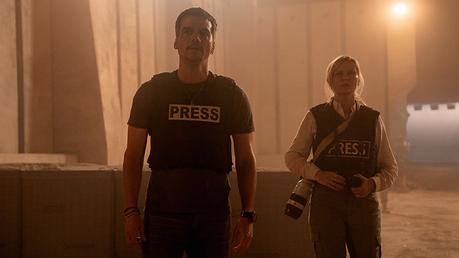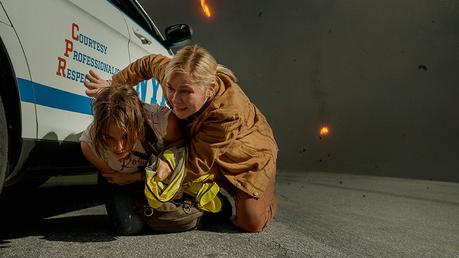With the recent rise of societal polarization and increased political tension in the US — especially during the Trump era, a film about a second civil war is inevitable. That’s when Alex Garland‘s Civil War comes into the picture. At least, that’s how it looks in the beginning; however, A24’s first foray into blockbuster is nothing like what it’s leading us to believe. It’s not an exclusive reflection of the country’s state of being.
Substitute the setting into another country, and you might still find the same story. The US’s deep-rooted political divide is only an inspiration among many others. Political leaders are violating constitutions for personal gain, repressive governments are killing civilians, and horizontal conflicts between government loyalists and the rest of the country lead to currencies crashing down in the wake of rising tension; these are recipes for disaster. And, it all exists in the world that Garland crafts for this hypothetical fiction.
Dystopian as it is, Civil War is the director’s most grounded work so far, yet ‘grounded’ is an understatement. This story is another entry to the director’s cabinet of speculative fiction, even when it’s not in the same league as Ex Machina‘s venture on a human Turing test or Annihilation‘s visual rendition of Lovecraftian horror. However, if any of the writer-director’s almost prophetical stories ever come to fruition, this one would be the closest we get to realization.
 Wagner Moura and Kirsten Dunst as two ambitious war journalists deep in the warzone
Wagner Moura and Kirsten Dunst as two ambitious war journalists deep in the warzone
A Street-view War
Civil War portrays the beginning of the titular war’s end. The totalitarian president (Nick Offerman) has cowered back in his office in DC when the Western Forces – an unlikely alliance between Texas and California – march on with the independently seceding Florida to win the war once and for all.
It’s not a helicopter view of the war; even we never know what started the war in the first place. All that we know is the president is currently serving the third term of his reign after disbanding the FBI and using lethal force to strike civilians. The story tracks four war journalists determined to cover the front line and the downfall of the authoritarian government, providing us with a street view of the ordeal.
A revered war photographer, Lee Smith (Kirsten Dunst), takes center stage with her comrade, Joel (Wagner Moura). After covering a violent protest in New York City, they plan to head to the frontline in Charlottesville before moving to the dangerous DC in an attempt to interview the president. Tagging along with them is Sammy (Stephen McKinley Henderson), Lee’s mentor, and 23-year-old Jessie (Cailee Spaney), an aspiring film photographer whom Lee eventually takes under the wings.
“Lee is losing faith in the power of journalism,” Sammy says, emphasizing Lee’s disillusionment about how her work, which she believes to be a cautionary tale for Americans, has fallen on deaf ears. “The State of the country is the QED,” both men agree.
Lee (inspired by real-life war photojournalist Lee Miller) has thrown herself amid open conflicts around the world, shooting hideous atrocities, sacrificing her mental state for something called passion. Yet, her country never learns from all the dreadful pictures she sent home. The US’s self-destructive nature seems like an inevitability. The PTSD from witnessing outright atrocities before Lee’s eyes (and the camera) has pushed her to the edge of bitterness and her sanity. When she sees the innocently curious and ambitious Jessie, she catches a glimpse of her former self – the innocent girl, matured by the face of death and the tender tutelage of Sammy.
The distance from New York City to doomed-to-fall D.C. isn’t that colossal. However, the impact of the war has made the trip virtually more taxing; the quarter has to traverse the war-ravaged states on a road trip – straying from the main road – that will challenge their life forever. There’s not much exposition detailing what truly happened in the background or what caused the war in the first place. The film, almost in a documentary style – with handheld camera works to make it more immersive, leads the audience to witness a lot of things and let us piece together whatever we can deduce from those situations.
In one sequence, we’ll encounter a group of armed mobs hanging looters while guarding a gas station – demanding 300 Canadian Dollars for provision. This is where we learn that the economy has fallen in the aftermath of the war. In another sequence, the group arrives in a small town where the war is virtually nonexistent and the society lives in a blissful ignorance. The next thing we know, the group is caught in a remnant of the Winter Wonderland fair — where two militia factions get involved in a sniper fight. When asked which side they’re fighting for, the two soldiers sneer back, saying that what matters is they don’t get killed by anyone who’s attacking them. However, the most baffling yet closest-to-reality ordeal comes from Jesse Plemons‘s small yet terrifying cameo as a xenophobic soldier. Aside from this cameo, there’s no real indication of how the war plays out and comes to what’s depicted in the film. Civil War lets audiences fill the void of information with anything and everything — regardless of subjective thought and reflective bias.
 Cailee Spaney and Kirsten Dunst in a master-protege relationship
Cailee Spaney and Kirsten Dunst in a master-protege relationship
Shooting with Cameras, Not Guns
Civil War attempts to capture the war from the most visceral point of view. Our protagonists capture the moment almost spontaneously in between gun standoffs and deaths. Real-time portraits of what the characters see are juxtaposed with the catastrophe that unravels. The sound of camera shutters breaks the harrowing sound of guns, explosions, and agonizing screams.
In between moments, we’ll learn how each character ponders on the impact of war on their lives — lamenting how some people refuse to believe that there is a war going on (a subtle nudge on people’s ignorance of the real-world conflicts happening outside the screen) or reflecting on how numb they’ve become to the deaths that surround them. While soldiers barge in the frontline, pointing their guns at the enemy, and pulling the trigger to capture victory, the protagonists shadow them, pointing the camera toward the event and shooting with their camera to capture the moment. Each moment unravels like an immersive horror; things can only get worse the deeper they get closer to the capital.
With the film’s episodic approach, Garland ushers the audience to the horror of the war through Lee’s connection with Jessie. At times, both characters seem vulnerable; yet, they can also seem numb on most occasions — probing questions to us. Is this how the film tells us that we are as guilty as those involved in the war by doing nothing than observing? However, Civil War is not a war of blame; it mostly captures and portrays the harrowing nature of it. The film’s lack of political stance seems off initially but becomes more understandable the further we get into the narrative. It’s only logical to do so given the protagonists’ disillusionment of the war.
Civil War might have a US setting, but this is not an exclusive portrayal of the US political landscape. This is a story of the fall of democracy that leads to horizontal conflicts; and, most essentially, this is a portrayal of how a modern war does to the society. It alludes to how similar events unravel in other regions, i.e., Lybia and Iraq, giving an ironic take on how the same thing can happen anywhere in the world without having to point out what can cause them. It’s not Zero Dark Thirty or Hotel Rwanda, despite being as immersive; it’s a film that unravels more like District 9. However, Garland‘s film is still as powerful despite being not having a clear-cut stance.
Verdict: Alex Garland’s most grounded film is possibly his most harrowing one. It ventures on the dystopian macabre through the lens of war journalists in the face of death — capturing the nightmarish falls of democracy from the street view and making a razor-cutting satire on the universal sense.
